You might not think it but martial arts in the Olympics date back to Ancient Greece. The first Olympic Games recorded were in 776 B.C., but there was only one event which was a running race named stadion or stade. It was until 708 B.C. before there was an official Olympic martial art and this was in the form of wrestling.
The next martial art came in 688 B.C. and was Ancient Greek boxing known as pygme/pygmachia which means fist-fighting. The last in the Ancient Olympic games was introduced in 648 B.C. and is known as pankration, a mix between boxing and wrestling. This included kicking, joint-locks, chokes, and holds like modern-day mixed martial arts (MMA).
With the downfall of Ancient Greece, the Olympic games stopped. This was until the modern games restarted officially in 1896 under the International Olympic Committee (IOC). Now, we’ll cover which martial arts are in the modern Olympic games and when each was introduced.
Contents
Wrestling (Greco-Roman and Freestyle)

Like in the Ancient Olympics, wrestling was the first martial art to feature in the modern games. The Greco-Roman style featured in 1896 and has featured in every Olympic Games since apart from in 1900 in Paris.
Freestyle wrestling was first introduced to the modern Olympic Games in 1904 and has been in every one since. That same year, weight classes were also introduced for both styles to make it fairer.
The USA has won the most medals in wrestling since 1896, although the former Soviet Union had the most gold medals. Russia is quickly catching up already with 30 gold medals in fourth place. This is only behind Japan with 37 golds and the USA with 60.
Women’s wrestling wasn’t introduced to the Games until 2004, less than two decades ago. The women’s competition focuses solely on freestyle, not the Greco-Roman style.
Here are the men’s and women’s weight classes from the most recent Olympics in Tokyo.
Men’s Freestyle
- 57kg (125.67 pounds)
- 65kg (143.3 pounds)
- 74kg (163.1 pounds)
- 86kg (189.6 pounds)
- 97kg (213.8 pounds)
- 125kg (275.6 pounds)
Women’s Freestyle
- 50kg (110.2 pounds)
- 53kg (116.8 pounds)
- 57kg (125.7 pounds)
- 62kg (136.7 pounds)
- 68kg (149.9 pounds)
- 76kg (167.6 pounds)
Greco-Roman (Men’s)
- 60kg (132.3 pounds)
- 67kg (147.7 pounds)
- 77kg (169.8 pounds)
- 87kg (191.8 pounds)
- 97kg (213.8 pounds)
- 130kg (286.6 pounds)
Fencing
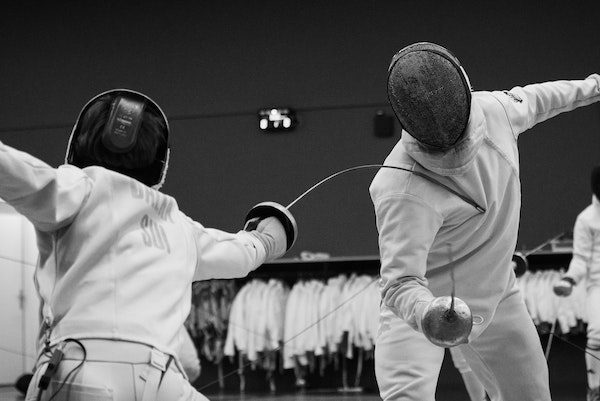
Fencing isn’t technically a martial art, but it is similar to other weapon martial arts. It was one of the sports that featured in the first modern games in 1896 and has featured ever since. There are 12 events in total six men’s and six women’s. Women’s fencing was first included in the 1924 Olympics in Paris.
Nowadays, both genders have the same events which are as follows:
- Foil – Individual
- Foil – Team
- Épée – Individual
- Épée – Team
- Sabre – Individual
- Sabre – Team
The three categories use different types of fencing swords, all with different rules. Foil is a light weapon for thrusting and you can only win by hitting the torso. Also, double touches aren’t allowed.
Épée is a heavier weapon, you’re allowed double touches and the target area is the entire body, not just the torso.
Finally, sabre is a light weapon that can be used for cutting as well as thrusting. The target area is any part of the body above the waist, except for the hands and the back of the opponent’s head.
Whenever a strike lands, the point will be declared on the electronic scoreboard which is connected to the uniform. The individual contests consist of three rounds of three minutes. The winner is the first to reach 15 points, or whoever has the most points at the end of the final round. If it is tied, then it goes to sudden death, whoever gets the next point wins.
The teams have three people and they compete 1v1 until each fencer has competed against each other. This means that there are a total of nine rounds. Whichever team gets to 45 points first wins or whichever team has the most points at the end of the ninth round. It’s a fascinating, fast-paced sport to watch so we highly recommend watching it. You can see a clip of the exciting men’s team foil final in 2012 below.
Unsurprisingly, the top countries in fencing are the ones that developed it into becoming a sport, Italy and France. Italy has 49 golds and 130 medals in total, France has 44 golds and 123 medals in total. In third place is Hungary with 38 golds and 90 medals.
Boxing
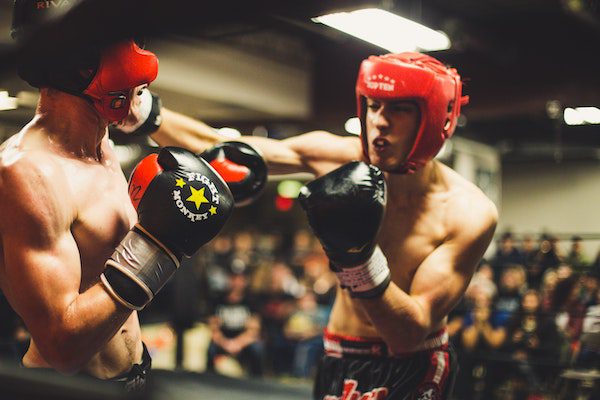
Boxing was the next martial art to enter the modern Olympic Games and this was in 1904. It has been featured in every games since apart from 1912 when it was held in Stockholm. At that time boxing was an illegal sport in Sweden which is why it wasn’t allowed.
Women’s boxing came even later than wrestling with the first games to hold it being London in 2012. The United States of America currently has the most boxing medals as well as the most golds. In second is Cuba and then Great Britain in third.
Over the years, many of the great boxers have turned professional after showing their worth on the Olympic stage. All fights at the Olympics have head guards unlike in pro boxing. It used to be that only amateur boxers could compete in the Olympics until the 2016 Games. Some of the greatest boxers of all time came through via the Olympics. For example, Muhammad Ali, George Foreman, Evander Holyfield, Floyd Mayweather, and Anthony Joshua.
At the most recent Olympics, there were eight men’s weight classes and five women’s. Here are the weight categories for both:
Men’s
- Flyweight – under 52kg (-114.6 pounds)
- Featherweight – 57kg (125.6 pounds)
- Lightweight – 63kg (138.9 pounds)
- Welterweight – 69kg (152.1 pounds)
- Middleweight – 75kg (165.3 pounds)
- Light heavyweight – 81kg (178.6 pounds)
- Heavyweight 91kg (200.6 pounds)
- Super heavyweight – above 91kg (+200.6 pounds)
Women’s
- Flyweight – under 51kg (-112.4 pounds)
- Featherweight – 57kg (125.6 pounds)
- Lightweight – 60kg (132.3 pounds)
- Welterweight – 69kg (152.1 pounds)
- Middleweight – above 75kg (+165.3 pounds)
Judo
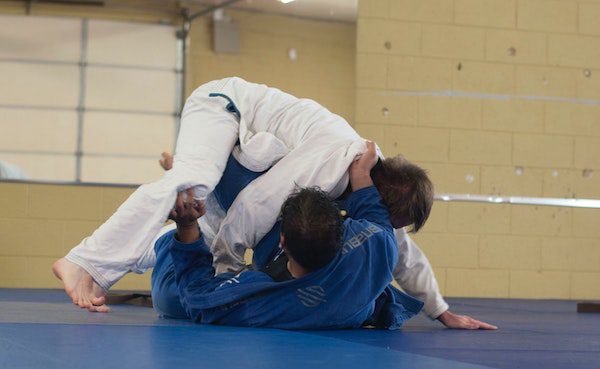
Judo, the Japanese martial art was introduced in the 1964 Tokyo Olympics. It then wasn’t included in the 1968 Olympics in Mexico but has been in every one since. Women’s judo was added to the Olympic Games in 1992.
To score points in judo you’ll need to take your opponent to the ground or throw them to the floor. You can also gain points for joint locks or a choke lock. If you score an ippon then you win immediately as that awards you 100 points. The other scorings are a waza-ari which is 10 points or a yuko which equals 1 point. If you manage two Waza-aris in the match then you immediately win like with one ippon.
There were seven men’s and women’s weight categories at the Tokyo Olympics in 2021. Plus, for the first time, there was a mixed team event that featured three men and three women in different weight classes.
Men’s
- Extra Lightweight – under 60kg (-132.3 pounds)
- Half Lightweight – 60-66kg (145 pounds)
- Lightweight – 66-73kg (161 pounds)
- Half Middleweight – 73-81kg (178.6 pounds)
- Middleweight – 81-90kg (198.4 pounds)
- Half Heavyweight – 90-100kg (220.5 pounds)
- Heavyweight – above 100kg (+220.5 pounds)
Women’s
- Extra Lightweight – under 48kg (-105.8 pounds)
- Half Lightweight – 48-52kg (114.6 pounds)
- Lightweight – 52-57kg (125.7 pounds)
- Half Middleweight – 57-63kg (138.9 pounds)
- Middleweight – 63-70kg (154.3 pounds)
- Half Heavyweight – 70-78kg (172 pounds)
- Heavyweight – above 78kg (+172 pounds)
As you’d expect, Japan leads the medals table with 48 golds and 96 total medals. Then, there’s a large gap with second as France holds 16 golds and 57 medals in total. In third place is South Korea with 11 golds and 46 medals.
Taekwondo
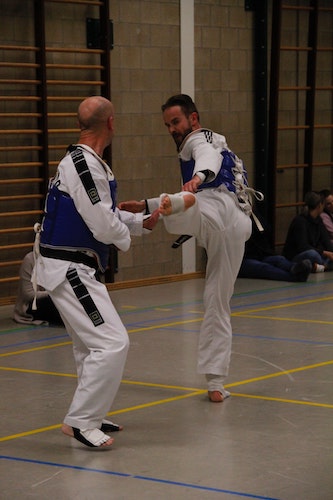
The Korean martial art Taekwondo took a while to join the Olympics. It was a demonstration sport at the Seoul Olympics in 1988 and again at the Barcelona Olympics in 1992. In 1996 it didn’t feature at all, but finally, at the 2000 Olympics in Sydney, it became an official Olympic sport. This meant that everyone contesting was doing so for medals.
Participants wear the typical white taekwondo uniform known as a dobok. Over the top of this is a protective octagonal area that is also the target area to hit along with the head. A head guard is also worn and men must wear a groin cup. Each taekwondoin needs to wear gloves, shin guards, and socks that are used for sensing contact. Of course, a mouth guard for safety too.
The protective gear is now connected with an electronic sensor which is called Protector and Scoring Systems (PSS). This enables the points to be awarded automatically, although judges can review points and award them manually. Here’s an overview of the point scoring:
- 1 point – for a penalty by the opponent
- 1 point – valid punch to the trunk protector
- 2 points – valid kick to the trunk protector
- 3 points – valid kick to the head
- 4 points – valid round kick to the trunk protector
- 5 points – valid round kick to the head
There are a few ways to win, the first being by a 20 point gap after the second round or at any time during the final third round. If the match is tied at the end of the final round, there is a golden point round which is sudden death. Whoever scores first wins the round, or if the other opponent gives away two penalty points.
There are currently four different weight classes for both men and women. These are the following:
Men’s
- Flyweight – under 58kg (-127.9 pounds)
- Featherweight – 58-68kg (149.9 pounds)
- Middleweight – 68-80kg (176.4 pounds)
- Heavyweight – above 80kg (+176.4 pounds)
Women’s
- Flyweight – under 49kg (108 pounds)
- Featherweight – 49-57kg (125.7 pounds)
- Middleweight – 57-67kg (147.7 pounds)
- Heavyweight – above 67kg (+147.7 pounds)
Karate
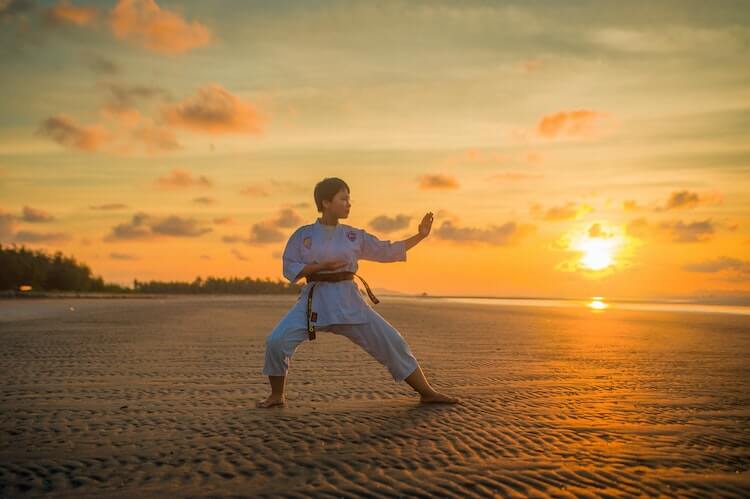
Karate is the most recent Olympic martial art as it made its debut in Tokyo in 2021. But, it won’t be part of the 2024 Olympics in Paris and it’s unclear whether it will be in any others in the future. It had been a long time coming as Jacques Delcourt started the conquest to get karate in the Olympics way back in the 1970s.
There were a total of eight karate events in Tokyo, four women’s and four men’s. These are split into two separate competitions Kumite (6) and Kata (2). Kumite is the fight competition whereas Kata is based on form.
Kumite
Kumite is semi-contact, you can be penalized for using full force and even disqualified. Competitors fight for three minutes and the winner is whoever receives eight points or more than their opponent.
If neither manages this, the winner is the one who has the most points at the end of the three minutes. If it is a tie then the winner is the person who scored the first point in the match. This is commonly known in karate as the senshu rule.
You can score one to three points and this is how the points are broken down:
- Yuko – 1 point
- Waza-ari – 2 points
- Ippon – 3 points
Yuko’s are awarded for punches with a closed hand or a strike to any part of the body above the waist. Waza-ari and ippons are awarded only for kicks, Waza-aris for hitting the entire torso, including belly, back, and sides. Ippons are only awarded for making contact with a kick to the head or neck of the opponent.
Kumite weight classes
Men’s
- Under 67kg (-147.71 pounds)
- 67-75kg (165.347 pounds)
- Above 75kg (+165.347 pounds)
Women’s
- Under 55kg (-121.254 pounds)
- 55-61kg (134.482 pounds)
- Above 61kg (+134.482 pounds)
Kata
As kata is purely judged on the correctness of the moves, there are no weight classes or referees involved. Two opponents compete with one wearing red and the other blue. They perform the techniques and five judges decide if the red or blue competitor performed the best.
With so many karate styles, the contests in the Olympics only allow styles that the World Karate Federation (WKF) recognizes. These are:
- Gōjū-ryū
- Shitō-ryū
- Shotokan
- Wadō-ryū
This has caused criticism as some karateka study different styles meaning they can’t compete; or if they do, they won’t be as proficient as others.
Medals
As karate has only featured in one Olympic Games, the overall medals table isn’t that interesting. Japan leads the way with the most medals (3) and one gold. Then, there are seven other countries with one gold medal but fewer total medals. These are – Spain, Egypt, Italy, Bulgaria, France, Iran, and Serbia.
Karate sometimes gets confused as being a Chinese martial art instead of Japanese. At least from those who haven’t practiced it. It was founded in Okinawa (southern Japan) so there’s no surprise that it won the most medals in its first Olympics. Although karate is popular all across the world.
FAQs
Which martial art was the first in the Olympics?
Wrestling was the first martial art in the modern Olympic Games and this was the Greco-Roman style. Fencing was also in the 1896 Olympics but many won’t consider it to be a martial art
When is Jiu-Jitsu going to be in the Olympics?
People have been asking if Brazilian jiu-jitsu (BJJ) will be in the Olympics and thought that it might debut in Rio at the 2016 Olympics. Although the popularity of BJJ is increasing quickly, we doubt it will be added any time soon.
First, it needs to be more widely spread around the world. It is similar to judo having branched off from this martial art which is already in the Olympics. Plus, there isn’t one single governing body that would increase the chances of it becoming an Olympic sport.
Will Mixed Martial Arts ever be in the Olympics?
Mixed Martial Arts (MMA) is another that many people ask, will it ever be in the Olympics. The International Mixed Martial Arts Federation (IMMAF) was only founded in 2012 and they are the ones pushing hard for it to be in the Olympics.
Though, many people outside of martial arts think that MMA is too violent for the Olympics. It would definitely have to be watered down to get approval which would go against the purists’ idea of MMA. Although all fighters would be amateurs and not professionals like boxing used to be.
Honestly, we doubt it’s going to be in the Olympics, at least not in the short term. We’ll have to wait and see.
Sources:
